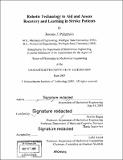| dc.contributor.advisor | Neville Hogan. | en_US |
| dc.contributor.author | Palazzolo, Jerome J | en_US |
| dc.contributor.other | Massachusetts Institute of Technology. Dept. of Mechanical Engineering. | en_US |
| dc.date.accessioned | 2006-08-25T18:56:40Z | |
| dc.date.available | 2006-08-25T18:56:40Z | |
| dc.date.copyright | 2005 | en_US |
| dc.date.issued | 2005 | en_US |
| dc.identifier.uri | http://hdl.handle.net/1721.1/33918 | |
| dc.description | Thesis (Ph. D.)--Massachusetts Institute of Technology, Dept. of Mechanical Engineering, 2005. | en_US |
| dc.description | Includes bibliographical references (p. 335-343). | en_US |
| dc.description.abstract | Each year, about 700,000 people in the United States have a stroke, making it a leading cause of serious, long-term disability. Modalities of therapy often assume the processes underlying motor recovery and motor learning are similar because both exhibit activity- dependent neural plasticity. However, the impact of other factors unique to recovery such as re-acquisition of muscle strength and resolution of abnormal muscle tone confounds the validity of this assumption. By implementing an adaptive impedance controller that collapses from a "virtual slot" between two targets to a "virtual spring" at the desired target, a new performance-based progressive therapy (PBPT) algorithm was developed to test whether recovery would be enhanced by incorporating learning strategies like repetition, goal specification, and positive reinforcement. A study of chronic stroke patients (8 to 95 months post-stroke) who were in a clinically verified "stable" phase of recovery was conducted with the PBPT protocol, in which patients made over 12,000 visually guided, point-to-point movements. | en_US |
| dc.description.abstract | (cont.) Though prior clinical results suggested that recovery would plateau 6 months post-stroke, two studies using sensorimotor (SM) and progressive resistance (PR) therapy protocols achieved significant, though modest, reductions in impairment. The new PBPT protocol produced significantly larger impairment reductions with over 6,000 fewer movements than SM and PR. By design, the adapting PBPT parameters, namely, the time allotted to move between targets and the virtual slot sidewall stiffness, serve as indicators of patients' abilities to move and aim (as parameters decrease (increase), patients move faster (slower) and require less (more) aiming assistance). By analyzing the parameters' evolution throughout the PBPT protocol, it was shown that motor recovery follows an exponential progression similar to a motor learning "law of practice". In addition, a serendipitous benefit of the PBPT protocol occurred - a sustained reduction in abnormal muscle tone, a factor unrelated to learning. A spectral impedance estimation method suitable for a clinical setting was developed and validated by identifying known mechanical systems. In addition, preliminary data was collected on unimpaired subjects and stroke patients. | en_US |
| dc.description.statementofresponsibility | by Jerome J. Palazzolo. | en_US |
| dc.format.extent | 343 p. | en_US |
| dc.format.extent | 19214204 bytes | |
| dc.format.extent | 19229359 bytes | |
| dc.format.mimetype | application/pdf | |
| dc.format.mimetype | application/pdf | |
| dc.language.iso | eng | en_US |
| dc.publisher | Massachusetts Institute of Technology | en_US |
| dc.rights | M.I.T. theses are protected by copyright. They may be viewed from this source for any purpose, but reproduction or distribution in any format is prohibited without written permission. See provided URL for inquiries about permission. | en_US |
| dc.rights.uri | http://dspace.mit.edu/handle/1721.1/7582 | |
| dc.subject | Mechanical Engineering. | en_US |
| dc.title | Robotic technology to aid and assess recovery and learning in stroke patients | en_US |
| dc.type | Thesis | en_US |
| dc.description.degree | Ph.D. | en_US |
| dc.contributor.department | Massachusetts Institute of Technology. Department of Mechanical Engineering | |
| dc.identifier.oclc | 67293169 | en_US |
